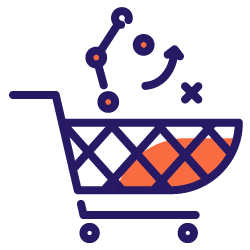The constant updating of algorithms and the way search engines work, as well as changes in user behavior, are forcing e-commerce owners to keep up. Online shopping is indeed an industry where competition is growing day by day and it is very risky for companies to fall behind.
In this article, I will focus on the new challenges in the world of e-commerce and how you can prepare for them and overcome them thanks to AI and new technologies. Not only that. I will show you how to interpret data from a semantic perspective to understand the traffic on your website and learn more about your target audience. This way you can optimize your product feed and implement your SEO strategy, increase your visibility and gain a competitive advantage that matters to your business.
How e-commerce SEO is changing pace
Semantic search
With the advent of the semantic web, search has also changed. This means that Google and search engines have begun to analyze the content and meaning of words to understand context and return more accurate and relevant results to users with their search intent.
When it comes to e-commerce, this is even more significant. In fact, if you want to showcase your products and store information for nearby shoppers searching with Google, you need to provide the search engine with all the information it needs (name, price, description, etc.) to understand what you are selling.Only then will the results be shown to a more qualified audience, thus increasing sales.
Multimodal search
Forget searching by text or image. Now search is multimodal. This means that users can combine information from multiple sources (images, text, audio, video) to find what they are looking for. As Prabhakar Raghavan, Senior Vice President at Google, said,
“Whether you’re humming the tune that’s stuck in your head or using Google Lens to perform visual searches (which now happens more than 8 billion times a month!), there are more ways to search and explore information than ever before.”
The search engine is no longer based on keywords but on search intent.
“[…] so you can find helpful information about whatever you see, hear and experience, in whichever ways are most intuitive to you. We envision a future where you can search your whole world, any way and anywhere”.
Bing Chat
Bing Chat can have a significant impact on e-commerce by providing a seamless and personalized customer experience. With Bing Chat, customers can ask questions, receive product recommendations, and get instant support, all in a fun and user-friendly interface. This can lead to higher customer satisfaction, loyalty and ultimately more sales.
In addition, Bing Chat can help businesses automate certain customer service tasks, freeing up time and resources for other important business operations. Overall, Bing Chat can improve the customer experience and give businesses a competitive edge in the e-commerce landscape.
SEO image optimization
In general, providing alt text and captions improves the accessibility of content for people using screen readers and helps search engines better understand what you are talking about or selling.
Using AI and rich language models, alt text and captions can be generated automatically to facilitate your image optimization processes. In this context, Andrea Volpini has tested a workflow for training, creating, and validating AI-generated alt text and captions. You can read the results in this article on image SEO with AI.
Generative AI in SEO
Generative AI in SEO is changing the way we do things. The large language models are evolving so that we can use them for an increasingly wide range of activities, such as creating internal links, FAQs, product descriptions, images, videos, and 3D models. A real revolution for those who own e-commerce, especially for large companies.
For example, the large language models (LLMs) such as BERT or GPT-4 are perfect for creating high-quality product descriptions that can increase the sales of an online store. We produce thousands of automated product descriptions daily, FAQ snippets, and more. The short form and stylized nature of product descriptions present the ideal circumstances for using LLMs considering the time and cost pressures of editorial teams working on thousands of products every day. The support of such tools saves a considerable amount of time and effort.
Be careful, because generative AI does not replace human work, but complements it by automating some steps of the content creation process, both textually and visually, saving time and energy of editorial teams. In addition, it can be used to create internal links for e-commerce category pages and then create so-called search widgets that recommend similar categories to improve internal linking and boost rankings. This means integrating AI into a workflow where machines and humans work together for optimal results. This is what we at WordLift experience every day, to provide our customers with innovative solutions that can deliver the business results they want.
How to increase your sales in this new scenario
Structured data plays a critical role in the new e-commerce scenario, where businesses increasingly rely on online sales to reach customers.
With structured data, companies provide search engines with valuable information about their products, such as pricing, availability, and reviews. This helps search engines better understand products, their features, and their uses, and also makes it easier for customers to find and buy what they are looking for. In addition, structured data helps companies and their products stand out in search results and increase their visibility, which leads to more traffic and sales.
As you can see, structured data is an essential aspect for businesses that want to succeed in the competitive world of e-commerce. It directly contributes to an enhanced user experience which consists of an ease of navigation and quick access to the relevant information. This, in turn, has a positive impact on sales and traffic
Building a product knowledge graph
Creating a product knowledge graph is an impactful step in terms of visibility, traffic and therefore sales.
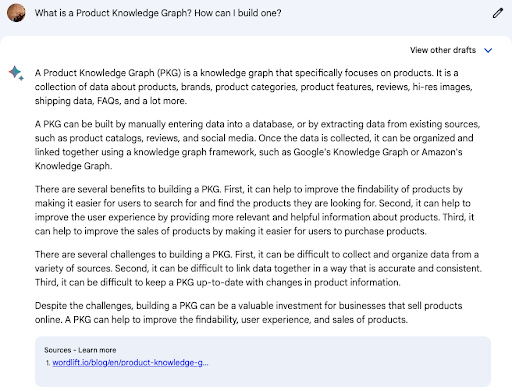
With a product knowledge graph, companies can ensure that their products can be found by the intended audience.
A knowledge graph is a structured data model that represents the relationships between different product attributes, such as brand, category, color, size and price. By organizing product data into a knowledge graph, companies provide Google and search engines with more detailed and accurate information about their products, making it easier for customers to find what they are looking for. This is especially important in e-commerce, where customers are increasingly using search engines and online marketplaces to find and buy products.
To build the product knowledge graph, you can start with the data you have about the products in your e-commerce. Maybe you have a product information management system where you store all the attributes of the products. Maybe you already share some of this data in the form of Google or Bing Merchant Feed or Amazon Seller Central Feed. These are XML files that allow these platforms to display your product on their interfaces. Or you may decide to crawl the site to extract additional attributes that help us build the knowledge graph.
Data synchronization and data reconciliation are two essential factors in this process. First of all, you need to make sure that the information comes from and matches the Merchant Feed to avoid errors. Secondly, you need to make sure that there are no duplicates that would lead to rejections by Google, which may decide not to show your products in the free listings.
By adding your structured data and creating your product knowledge graph, you can also increase visibility in the Google Shopping free listings. An area that until recently was reserved for those who invested in advertising, now offers smaller businesses the opportunity to sell their products for free on Google.
[Ebook] 5 KPIs that reveal top strategies for successful ecommerce SEO
How to read data from a semantic SEO perspective for e-commerce
By adding structured data and creating a product knowledge graph, your e-commerce dataset becomes rich with useful information for search engines to better understand what you are selling and make you visible to a more qualified audience. This has great business benefits as it increases both sales and brand awareness. In addition, you can use structured data to analyze your traffic performance and optimize your content for a better customer journey on your website.
You can use Google Looker Studio to blend the data from different sources, like your Knowledge Graph (structured data), GSC, Google Analytics, etc. and measure the impact of your semantic SEO strategy.
To use Google Looker Studio to analyze traffic data for your e-commerce, you can follow these steps:
- Connect your e-commerce platform to Looker Studio, either through an API or a pre-built connector.
- Create a Look or a dashboard in Looker Studio to visualize your traffic data. You can use pre-built templates or customize your own.
- Choose the relevant dimensions and metrics to analyze your traffic data, such as page views, bounce rates, or time spent on site.
- Filter and segment your traffic data to gain deeper insights, such as analyzing traffic by location, device type, or referral source.
- Use Looker Studio’s visualization tools to create charts, graphs, or tables that highlight key trends or anomalies in your traffic data.
- Share your findings with your team or stakeholders, either through Looker Studio’s collaboration tools or by exporting your data to other tools or platforms.
By using Looker Studio to analyze your traffic data, you can gain a better understanding of your customers’ behavior and preferences, optimize your website performance, and ultimately, drive more sales and revenue for your e-commerce business.
Analyze the data based on specific attributes
Using structured data to semantically analyze your traffic data allows you to filter information based on specific product properties or attributes. For example, you can analyze your organic traffic based on the material of a particular product and get information about which materials are used in the most searches.
As you can see in the image, suede leather emerges as the material with the most searches.
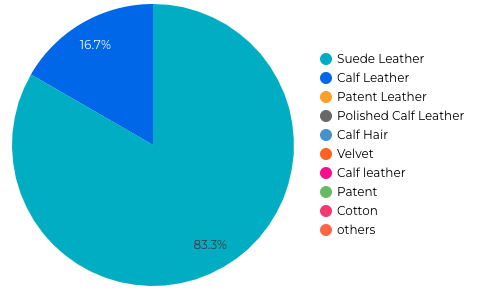
This allows you to analyze demand from organic traffic and understand what materials are most searched by users. Information that other sources can not give you, such as Google Search Console, which does not allow you to filter data in this way, is critical to better understand what your audience is looking for and therefore how you can work to optimize their customer journey and increase purchases.
Interpret search intents using entities
Analyzing the attributes of a product through structured data will help you improve your content strategy. While the data obtained from Google Search Console only shows the most searched queries related to your e-commerce business, analyzing the most searched attributes allows you to find more specific search queries that generate interest in your product and that you can target to the audience’s informational intent.
In this way, you can drive users to buy by using these long-tail search queries, building a more effective customer journey that will allow you to have a positive impact on your SEO but also on your business.
We know that user decision making is not linear. As the model outlined by the Google researchers clearly shows, we are dealing with a messy middle, i.e., a journey that includes very chaotic and different touchpoints, starting with the initial need impulse (trigger) and ending with the actual purchase, and that changes with each person.
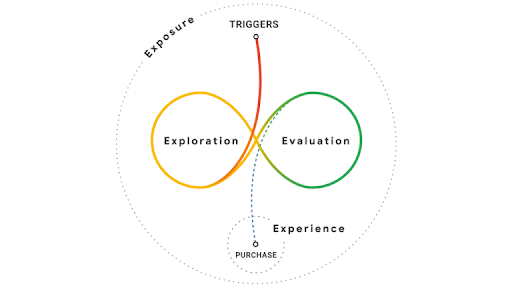
The messy middle refers to the phase of the customer journey where customers actively consider different options before making a purchase decision. This stage is critical for e-commerce websites, as it provides an opportunity to offer relevant and compelling content that can persuade customers to make a purchase, especially in the exploration and evaluation phases.
Entity analysis can help you optimize your e-commerce content, both existing content and new content you need to create. For this analysis, you can use this SEO Add-on for Google Sheets, for example. It’s a user-friendly tool that, with just a few clicks, compares queries or URLs, or both, to show you which entities can enrich your content and beat the competition.
In the following example, we have compared two URLs that point to the same product on two platforms. As you can see, in the first case the entities mentioned in the text are few (look at the number of occurrences) and refer to a single season, brand, style. In the second case, on the other hand, the focus is on the intended use and other attributes such as color, material, brand, which are absent in the first case.
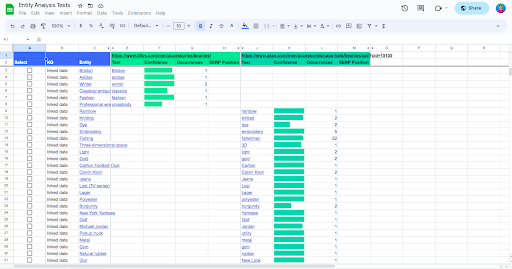
Reading the data from a semantic SEO perspective allows you to analyze the demand and define a content marketing strategy that addresses this need and targets the queries that will actually bring qualified and ready- to-buy visitors to your e-commerce website and increase sales.
Analyze FAQ page markup
Another important element that can be added to this type of analysis concerns FAQs. With GSC, you can use the filter to see pages that have appeared as FAQs, regardless of what markup they have. With semantic data analysis, you can see which pages with FAQ markup drive more traffic to your content and thus better meet users’ information needs.
As you can see from the graph below, you can also optimize your editorial plan by analyzing the queries generated by FAQs. Based on the ratio of CTR to position, you can see, for example, which queries generate more traffic but a lower conversion rate, and then think about solutions that make clicking easier by leading to content conversion.
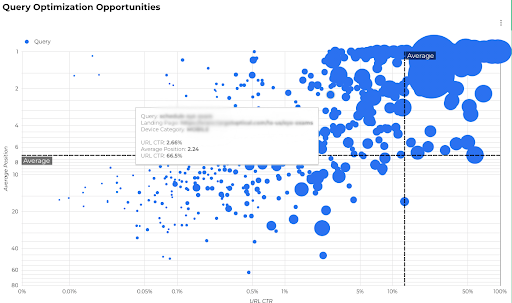
In this way, you can also avoid cannibalizing content marked with FAQs. Cannibalization, in content marketing and SEO, is the phenomenon of multiple pages on a website competing for the same keyword or topic, resulting in a drop in search engine rankings and traffic.
This happens because the pages refer to the same keyword, so the search engines cannot figure out which page is the most relevant and authoritative. Cannibalization affects the ranking for keywords that are important to the business.
It’s important to understand how to manage this phenomenon. Semantic data can help you take your analytics and optimization capabilities to the next level.
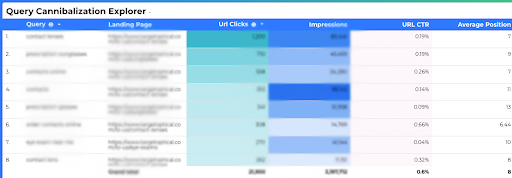
Conclusion
In conclusion, an effective e-commerce website requires a strategic approach that considers various tactics and metrics.
By reading data from a semantic SEO perspective for your e-commerce you can learn where more needs to be done and where you are already performing well. In particular, you can:
- Develop a deeper understanding of your customers
- Improve your lead generation funnel
- Benefit from e-commerce trends in your industry
With the right tactics and metrics, businesses can optimize their e-commerce website to drive more traffic, increase sales, and ultimately achieve their business goals.
